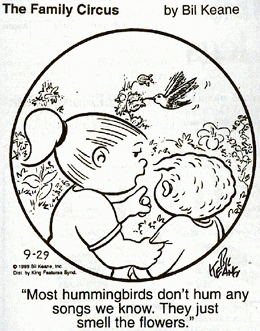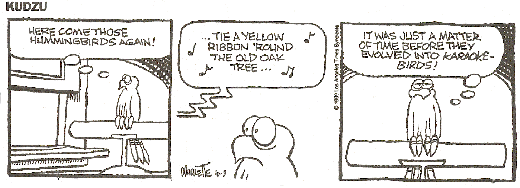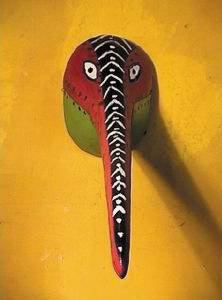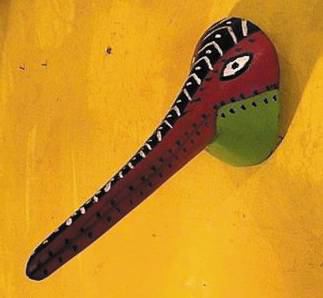|
|
|
|
|
|

Ruby-throated Hummingbirds (Archilochus colubris)--in part because of their iridescent colors, streamlined shapes, association with plants, and atypical behaviors--are wonderful subjects for artistic representations in all sorts of media from sketches to computer-based illustration, from sculpture to T-shirts, and from watercolors to photographs (slides, prints, and digital stills or video).
We hope you'll want to share your original hummingbird artwork through publication on Operation RubyThroat. If so, contact PROJECTS.
In the meantime, here are some ideas for teachers, students, and other individuals to try.
Teachers and their student groups, individual students, and others who are registered participants with Operation RubyThroat get priority attention to all requests for information and assistance. To register, see How to Participate.
|
ART ACTIVITY #1: Because of their distinctive behaviors -- being able to hover, feeding from flowers, spending winter in the tropics, etc. -- Ruby-throated Hummingbirds make good subjects for a humorous (but informative) cartoon or cartoon strip. First, have your students look analytically at the comics section of a Sunday newspaper. Then, using facts and illustrations available on the Operation RubyThroat website, have them develop a hummingbird concept that can be illustrated as an original captioned single-panel cartoon (such as the one at right) or story-board cartoon (below). (Have students be careful with facts; despite the Family Circus cartoon caption , hummingbirds have NO sense of smell.) |

©1999 by Bil Keane & King Features Syndicate ACADEMIC DISCIPLINES: Art, creative writing--plus hummingbird science. MULTIPLE INTELLIGENCES: Linguistic, Spatial, Interpersonal |

©1999 by Doug Marlette & Los Angeles Times Syndicate |
|
Back to Top of Page
It's REALLY hard to set up a still camera that can capture a fast-moving hummingbird, but it's EASY for your students to capture a hummingbird on videotape.
Place a video camera on a tripod and aim the camera at a feeder that is being frequented by Ruby-throated Hummingbirds. Zoom in with the camera's telephoto function. You can start the camera and walk away from it to do other things and just let the camera run until the tape runs out. (This can last 2 hours or more, so it may be useful to hook the videocamera up to an outlet rather than depend on the battery.) Rewind the tape, load it into a VCR, and fast forward until a hummingbird image shows up on the screen. (Students find the fast forward aspect to be great fun!) Then you can transfer the footage that contains hummingbirds onto another tape, eliminating any "dead footage" that doesn't contain hummingbirds.
Or, if you'd rather stay at the videocamera, have it on standby and start the tape rolling as soon as a hummingbird comes into view. If you have a remote control for the camera, you can also set up the tripod in a Hummingbird Garden, pre-focus the camera on a flower head and watch through binoculars. Use the remote to start the camera when a hummingbird approaches the flowers.
Add original music, voice-overs of students reading their hummingbird poems, interesting facts about hummingbird life histories (as found on the Operation RubyThroat website), or natural sounds--including, of course, hummingbird wings humming!
ACADEMIC DISCIPLINES: Art, music, creative writing--plus hummingbird science.
MULTIPLE INTELLIGENCES: Naturalistic, Linguistic, Spatial, Musical
Back to Top of Page
Using illustrations from books, magazines, the Operation RubyThroat website, or other Internet hummingbird resources, have students make quick sketches that show any differences in appearance for the four age/sex classes of Ruby-throated Hummingbirds (adult male, adult female, juvenile male, juvenile female--as described elsewhere on this website.). Render these sketches onto heavy paper (poster board or thicker) as watercolors, pen-and-ink, acrylic, or other drawing/painting style. Cut out the completed images. Using coat hanger wire, quarter-inch (0.64cm) wooden dowels, and string (or colored yarn or fishing line monofilament), create a mobile that uses the hummingbird illustrations. To make a more artistic, better balanced, and more instructive mobile, include to-scale renderings of other hummingbird-related objects (e.g., a hummingbird nest, different kinds of hummingbird flowers, etc.).
Hang the completed mobile in the classroom as a winter-rime reminder that hummingbirds will return again in the spring.
ACADEMIC DISCIPLINES: Art, on-line technology, math (calculating and measuring parts for mobile)--plus hummingbird science.
MULTIPLE INTELLIGENCES: Spatial, Logical-Mathematical
Back to Top of Page
Paperfolding, or origami, is a time-honored traditional art form in Japan. The Hummingbird Origami included here as part of Operation RubyThroat is fairly complex and is most suitable for students in grades 7-12. As part of the exercise, have students read about origami or conduct on-line searches about the history of paper-folding. As additional inquiry, have students weigh the origami hummingbird when complete and compare its mass to that reported elsewhere on this website for a live Ruby-throated Hummingbird. Click here for the folding instructions for Hummingbird Origami #1.
ACADEMIC DISCIPLINES: Art, art history, geography, math, measurement, on-line technology--plus hummingbird science.
MULTIPLE INTELLIGENCES: Spatial, Logical-Mathematical, Linguistic, Interpersonal
Back to Top of Page
Using illustrations from books, magazines, the Operation RubyThroat website, or other Internet hummingbird resources, have students create a hummingbird mask from paper mache are cardstock. The mask below was created in Carpinteros, a small town the state of Hidalgo, Mexico. It is an Otomí community in the cloud forest of the eastern Sierra Madre Mountains. The mask and others like it are worn during carnival in February when, villagers masquerading as large "flocks" of birds wander throughout the community and neighboring ranches. This mask was created in the late 20th century and is carved from one block of wood; it measures 8" x 17". Students could also make a set of miniature masks rather than full-sized ones.
 |
 |
ACADEMIC DISCIPLINES: Art, on-line technology--plus hummingbird science.
MULTIPLE INTELLIGENCES: Spatial, Logical-Mathematical
Back to Top of Page
Back to Cross-disciplinary Activities
Go to Activities in Drama or Geography or Math or Music or Writing
Up to Top of Page
|
Make direct donations on-line through
Network for Good: |
 |
|
LIKE TO SHOP ON-LINE?
Donate a portion of your purchase price from 500+ top on-line stores via iGive: |
|
|
Use your PayPal account
to make direct donations: |
|
|
|
Share Your Hummingbird Experiences Through "Hummingbird Hobnob" |
 |
Operation |
|
|